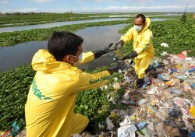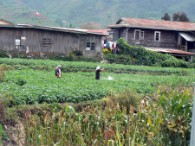-
Laguna Lake, The Philippines: Industrial Contamination Hotspots
Contamination of natural water resources by discharges from the industrial sector in the Philippines continues to be a significant problem. In 2007, Greenpeace launched the Water Patrol to document the impact of water pollution on local communities in the Philippines. Within the framework of this project, several industrial sites located around Laguna Lake were visited…
-
Dirty Laundry 2: Hung Out to Dry
Research commissioned by Greenpeace International has revealed that clothing and certain fabric-based shoes sold internationally by major clothing brands are manufactured using nonylphenol ethoxylates (NPEs). NPEs -- which are used as surfactants in textile production -- subsequently break down to form toxic nonylphenol (NP). Nonylphenol is a persistent chemical with hormone-disrupting properties that builds up…
-
Marilao River is one of spotlight case studies in new Greenpeace report on Hidden Costs of Toxic Water Pollution
The Marilao in Bulacan is among four iconic rivers whose polluted conditions are spotlighted in ‘Hidden Consequences’, a new report published today by Greenpeace. The report calls for urgent action to protect the livelihoods of the people and wildlife that depend on these waterways and the life-sustaining resources that they provide, by demanding that policy-makers…
-
Water Patrol documents the threats to Majayjay’s waters
Reflection of the vegetation on irrigation water from Mount Banahaw. The world celebrates World Water Day every March 22. This year, some 50 members of the Greenpeace Water Patrol went…
-
Greenpeace Water Patrol investigates polluting garbage dump in Laguna Lake
Greenpeace Water Patrol activists today investigated a dump site in Angono, Rizal which has taken over the banks of Laguna Lake, and called on the government for the strict enforcement of waste laws to protect the country’s threatened freshwater sources.
-
Agrochemicals a major source of water pollution, Greenpeace says
Decades of agrochemical use in the Philippines and Thailand has polluted water sources in the country and are directly posing risks to human health and the environment, Greenpeace said today at the launch of a new study entitled "Agrochemical use in the Philippines and its consequences to the environment." The environment group additionally called on…
-
Drinking water in Philippines, Thailand contaminated with nitrates, Greenpeace says
Water in key agricultural areas in the Philippines and Thailand are already contaminated with nitrate pollution, Greenpeace warned today at the launch of a new report, Nitrates in drinking water in the Philippines and Thailand. The report, launched simultaneously in both countries, is the result of a Greenpeace Water Patrol investigation which studied nitrate levels…
-
Greenpeace ‘Water Patrol’ spotlights toxics pollution in Marilao River
A team of Greenpeace ‘Water Patrol’ activists today called attention to the shocking extent of pollution in Marilao River by unfurling a 28-meter banner with the words “Stop toxic pollution, protect our water resources” along Marilao Bridge in Bulacan province, 25 kilometers north of Manila. The activists also floated giant rubber fish skeletons along the…
-
Greenpeace launches ‘Project: Clean Water’
Citing the urgent need to safeguard the country’s precious fresh water resources from contamination, Greenpeace today launched ‘Project: Clean Water,’ an initiative that aims to catalyze action to protect Philippine fresh water sources.
-
The state of water in the Philippines
This report gathers available information regarding water resources in the Philippines, focusing on the issues of pollution, especially of drinking water and freshwater sources, and water scarcity. It also reviews the country’s existing legal and policy frameworks for water use, quality control, and management.









